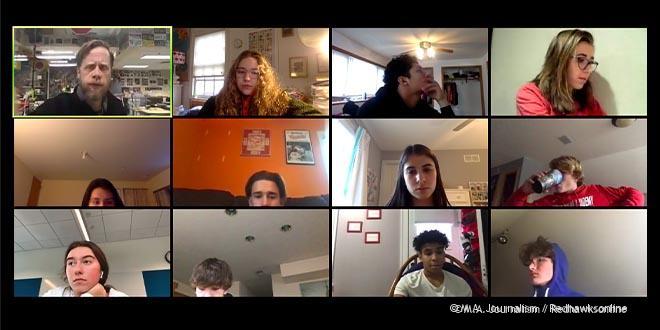Minnehaha takes on round 2 of digital learning
“You’re on mute.” “Turn your camera on, please.” For better or worse, online school is back.
Due to a recent surge in COVID-19 cases across Minnesota, Minnehaha Academy shifted to 100% distance learning on Nov. 30. After 12 weeks of in-person learning to start the year, all students were sent home and expected to engage in distance learning until Jan. 19, when second semester begins.
Students and faculty both made adjustments to accommodate the changes. Most students and faculty could draw from experience in April and May to help ease the transition to full distance learning this fall. During the school’s first online school experience both teacher and students were unsure of the way distance learning was going to play out.
“Last spring we did online school but not planning too specifically, too far into the future,” said Kris Sauer, English teacher at Minnehaha. Sauer added that teachers tried “to make learning activities as beneficial and meaningful as possible without being overwhelming.”
Despite these creative planning adjustments, most students and teachers prefer being in person over online.
“There is no denying that students are typically going to be more engaged and more focused when they are in school in person,” said Micheal DiNardo, Minnehaha’s upper school principal.
“I am so impressed with the adjustments teachers have made to deliver instruction in this online format,” DiNardo said. Many teachers tried to make distance learning as “face to face” as possible, hoping that this way students would stay more engaged.
Students agree. School engagement and interaction between people cannot be matched in an online format.
“Obviously the engagement is not as good as when we are in person,” said Aliyah Freeman, a sophomore.
Teachers made adjustments to make distance learning more like “face to face” learning. They helped students connect with the class materials and with each other.
“It is so much better and more fun to be in class on Zoom rather than just getting a lesson or watching a video,” Freeman said. “It helps me to be more engaged when I can have a live lesson with my teachers and be able to work with my classmates.”
Online learning poses many challenges, one being the accountability of students, and not being able to follow up with students as directly.
“There was no accountability because there we didn’t see kids at all. So you had to kind of take their word for it if they’re doing assignments.” said Stromberg about last spring. “And it got to the very end and some work and others really hadn’t done anything the entire time,”
Many teachers came up with new ways for online school this winter. Teachers of all different subjects came up with their own way to keep students engaged and involved with class. Many teachers used Zoom and asked students to keep their cameras on.
Hands on courses like art and music were particularly affected.
“I was trying to do sculpture projects by having them raid their recycling bins and cut up plastic and newspaper. And there were even some kids that didn’t have that kind of stuff,” Stromberg said.
This year with more lead time teachers were more prepared for the transition. Collin Quinn, a social studies teacher, gave students frequent assessments to check their engagement in class.
“I would always end the week with like a culminating activity or test, like each week in APUSH [AP U.S. History] they wrote an DBQ essay [Document-Based Question, a staple of AP history classes] … so for me it was kind of checking in,” Quinn said.
Quinn used his class’s assessment to check the progress of the students in his class, which helped him become more aware of students’ participation in class.
Communication during distance learning becomes more challenging and, in some ways, more important. It is difficult for students to stay involved in the process of learning, so students must message, email and speak up during online courses. Teachers can no longer easily scan a room to read body language cues. All of these factors make it more challenging for students to stay engaged with their classes and teachers.
“As a language teacher I’m trying to get as much input to students, students hearing as much Spanish as possible and then using the language as much as possible,” Anne Calvin, a Spanish teacher, said. “It’s very, very difficult to think of how to best do that when we’re not together. So, in terms of language input, I would say that’s definitely compromised.”
As complicated as it may seem to fix the communication issue, there were ways that teachers tried to minimize it. Teachers utilized the tools that were available. For example, Zoom. Even though this doesn’t fix the barrier in communication, it helped.
Zoom and other video platforms helped communication between students and teachers. Many teachers used these apps to help promote better learning over a distance.
“I think Zoom is a game-changer and just all of us students and teachers are just trying to find our way,” Calvin said. “I feel like teachers have more clarity and a better handle on what works versus what doesn’t work, but at the same time recognizing that nothing really is a replacement for meeting together.”
Throughout all the challenges that teachers and students faced during online school, the effort and hard work ended in successful learning for students. This time of online learning ended up with teachers and students appreciating the time of in person learning.

